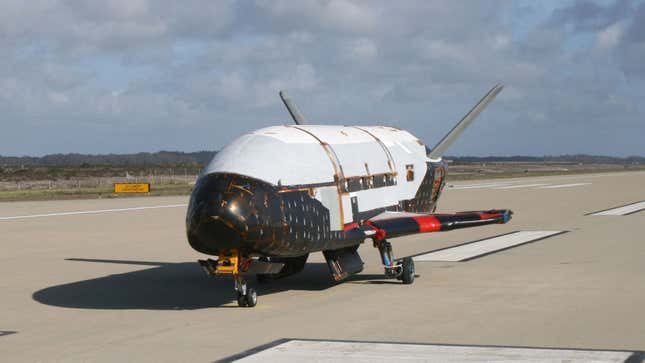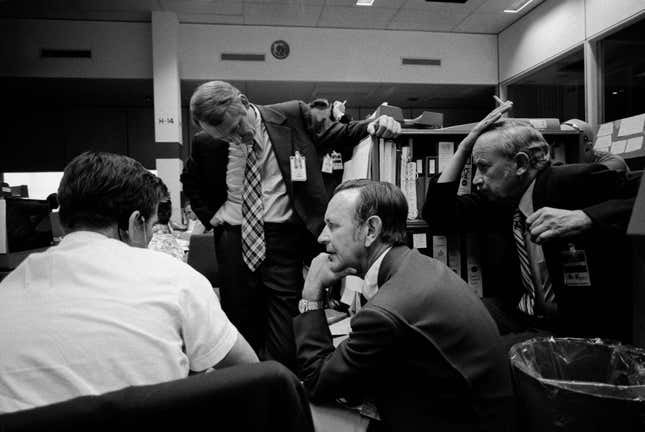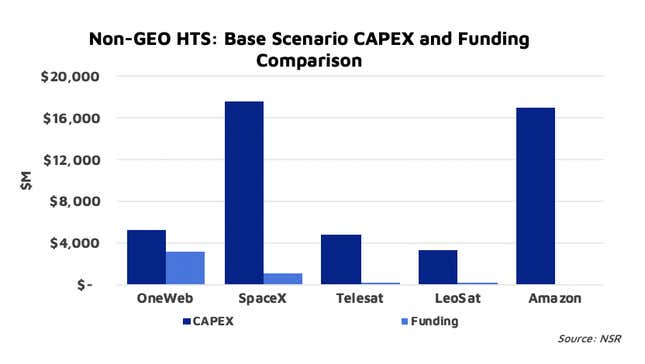Dear readers,
It’s the eighth edition of Space Business, Quartz’s newsletter on the economic possibilities of the extra-terrestrial sphere. Please forward widely, and let me know what you think. This week: TOP SECRET SPACE, the man behind mission control, and duty-related crimes.
🌘 🌘 🌘
The US Air Force X-37B is my favorite secret spacecraft, mainly because it isn’t very secret at all.
The Boeing-made vehicle, just under 30 feet (9.1 meters) in length, looks like a small-scale version of the Space Shuttle. There’s one zipping around the planet right now, and in a previous mission, it spent 675 days orbiting the earth, ostensibly acting as a platform to test new technologies and materials over long periods. Uniquely, it can fly back to earth autonomously and generate lift to land on a runway—and it may be able to maneuver relatively freely in space (a rare capability for satellites).

Recently departed Secretary of the Air Force Ellen Wilson has shed some new light on this question. She said that the X-37B can fly close enough to the earth’s atmosphere to dip into it and maneuver, changing its orbit. Why does that matter? When militaries track an object in space, they typically spot them with a radar or another sensor for a brief period, then extrapolate their path based on orbital mechanics. Wilson’s revelation suggests that the X-37B can fool observers if it changes its path while out of range of their radar.
“Which means our adversaries don’t know…where it’s going to come up next. And we know that that drives them nuts. And I’m really glad about that,” Wilson said. Making sure that China and Russia know about the X-37B is kind of the point—a reminder that the US, though it hasn’t tested an anti-satellite weapon as recently as China, Russia, or India, still has military options in space.
This signaling might backfire. Brian Weeden, a space security expert, told Military.com he was skeptical of the strategy: “It will create more diplomatic problems for the US when it tries to point out Russian and Chinese ‘unusual behavior in space’ and push for discussions on space norms of behavior.” Thus, when the US complains about Russia testing its military spacecraft dangerously close to other satellites, “[the X-37B] gives Russia and China one more talking point about how the US is the one ‘weaponizing’ space, even if that’s not true.”
Some amateur space trackers are skeptical of Wilson’s claims that it is difficult to spot the X-37B, suggesting that publicity may serve as a smokescreen for the real mystery: what the spacecraft has been testing up there. Speculation ranges from eavesdropping on other satellites to launching and recovering smaller free-flying spacecraft. With the US plotting a bulked-up military space service, one thing’s for sure: The X-37B is only the beginning.
🌘 🌘 🌘
Imagery Interlude: Where would the Apollo program be without rows of serious men (and one woman) in front of old-timey computer workstations? The inventor of mission control, Chris Kraft, passed away on July 21. Center stage in the photograph below, he’s seen as the director of Johnson Space Center in 1973, working through a problem with a Skylab mission.

During his 25-year career at NASA, Kraft saw the US space agency through the initial development of human spaceflight through to the space shuttle.
🌘 🌘 🌘
SPACE DEBRIS
India to the moon. The Indian Space Research Organization launched its Chandrayaan-2 mission to the moon on July 22. India has a shot at being the fourth space power to perform a soft landing on the lunar surface, after the US, Russia, and China. When it arrives around Aug. 20, the mission will attempt to be the first to land near the lunar south pole and deploy a rover to analyze its chemical composition. If the mission returns more evidence of water ice in the moon’s polar regions, that will provide a boost to NASA’s own moon-exploration schemes.
A habitat for humanity. NASA has selected Northrop Grumman to develop a habitation module for its Lunar Gateway. The module will provide astronauts with a rest stop on journeys between the earth and the moon, and vice versa. But the contract—which was not put up for competitive bidding—doesn’t jibe with NASA’s plans to leverage private investment into its Artemis moon-return program. NASA says the choice was made because Northrop is the only company that can meet the 2024 deadline set by the White House. Before that deadline was proposed, NASA administrator Jim Bridenstine said, “We are not in a space race. Look, that race is over, we went to the moon, we won. Now we’re in a position where we can take our time and make sure we get it right.” That changed quickly!
A European satellite feud. Inmarsat had a smart idea to make airplane wifi better: Use satellites in combination with receivers on the ground to provide a better connection. With some work, the European Aviation Network was launched last year in collaboration with Deutsche Telekom. One problem: Inmarsat’s competitor Eutelsat hates it, and has been arguing in various venues that the company can’t transmit from the ground, since it is licensed to use its radio spectrum with satellites. Now the battle is going to the Court of Justice of the European Union, which should be great fun for all involved.
China space official in hot water. A former official who supervised space tracking technology for China’s Central Military Commission has been detained “for suspected serious violations of discipline and duty-related crimes.” Details are scarce, but the language used by officials is similar to that deployed in the broader crackdown against corruption launched by Chinese president Xi Jinping.
Fit or smart but rarely both. A new report from Northern Sky Research offers useful comparisons of the five major efforts to fill low-earth orbit with swarming internet satellites. The total cost for all the proposed constellations is $48 billion, but it’s unlikely that all that money will be spent. Analyst Shagun Sachdeva has come up with a nice metric to compare the survival of the companies that have lots of money behind them (the fittest) and those with the best fit to market (smartest).

Predictably enough, SpaceX has the most expensive and ambitious plan. OneWeb’s dreams most closely match its capital raise. And everyone is taking Amazon’s entry seriously because, hey, it’s Amazon.
your pal,
Tim
Hope your week is out of this world. Please send information about classified space programs, evidence of duty-related crimes, tips and informed opinions to tim@qz.com.